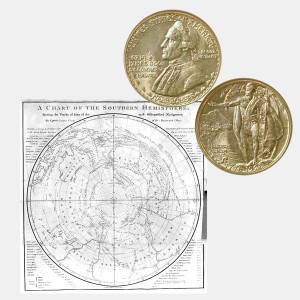Today, the Hawaii Sesquicentennial Commemorative Silver Half Dollar Coin with its image of Captain Cook remembers when he first crossed the Antarctic Circle on January 17, 1773.
From the Journal of the Franklin Institute, Volume 151, published in 1901:
=====
Lieut. James Cook, R.N., on a voyage round the world in the ship “Endeavour,” went just beyond 60 degrees south latitude, between 74 and 75 degrees west longitude, on January 30, 1769.
When approaching New Zealand, on October 7, 1769, he wrote: “This land became the subject of much eager conversation; but the general opinion seemed to be that we had found the Terra Australis Incognita.”
Lieutenant Low states that an English geographer, Alexander Dalrymple, published a paper about 1770, asserting the existence of an Antarctic continent extending north of 60 degrees south latitude, and that Captain Cook searched for this on his second voyage round the world.
Captain Cook commanded the “Resolution,” and Captain Furneaux commanded the “Adventure.”
At the Cape of Good Hope they found the Swedish naturalist, Dr. Andre Sparrman, and invited him to join the expedition.
From the Cape, Cook proceeded south and east, and on January 17, 1773, crossed the Antarctic Circle in 39 degrees 35 minutes east longitude, and reached 67 degrees 15 minutes south latitude.
Here he was stopped by a pack composed of field ice, with thirty-eight ice islands in sight. He turned northward and later southward.
On the 23d of February he reached 61 degrees 52 minutes south latitude, 95 degrees 2 minutes east longitude.
Here there were so many ice islands that he gave up attempting to cross the Antarctic Circle, and continued on an easterly course until, on March 17, he reached 59 degrees 7 minutes south latitude, 146 degrees 53 minutes east longitude, when he bore away north.
In December, 1773, Cook again went south, and on December 22d reached 67 degrees 31 minutes south latitude, 142 degrees 54 minutes west longitude, where he was stopped by the pack.
On January 30, 1774, he reached 71 degrees 10 minutes south latitude, 106 degrees 54 minutes west longitude, where a great ice field, in which ninety-seven ice hills were in sight, blocked further progress.
He then went in search of the Terra Australis Incognita that Juan Fernandez was said to have discovered.
In January, 1775, Captain Cook went south from Staaten Land, on a search for La Roche’s Island.
On January 14, in 53 degrees 56 minutes south latitude, 39 degrees 24 minutes west longitude, he sighted land, which is undoubtedly the one discovered, perhaps by Amerigo Vespucci, certainly by La Roche, and which was seen by the Spanish ship “Leon.”
It lies between 53 degrees 57 minutes and 54 degrees 57 minutes south latitude, and 38 degrees 13 minutes and 35 degrees 34 minutes west longitude.
Cook spent several days there and renamed it the Isle of Georgia. He then stood eastward again, and on January 31st sighted land in 59 degrees south latitude, 27 degrees west longitude, and on the same day another coast in 59 degrees 13 minutes south latitude, 27 degrees 45 minutes west longitude, which was named Southern Thule.
On February 1st he sighted Cape Montagu, and on the 3d, in 57 degrees 11 minutes south latitude, 27 degrees 6 minutes west longitude, two islands, which he called the Candlemas Isles.
After a vain search for Bouvet Island, he returned to the Cape.
This voyage of Cook was important, because it was the first one to circumnavigate Antarctica, and to circumscribe its limits; and also because it did away with the belief in a Terra Australis Incognita north of 60 degrees south latitude.
=====
The Hawaii Sesquicentennial Commemorative Silver Half Dollar Coin shows with a chart of the Southern Hemisphere showing the tracks of some of the most distinguished navigators, by Capt. James Cook, circa 1777.
